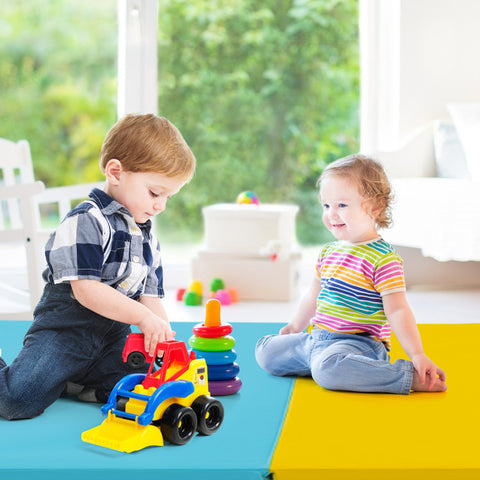News
Heat & Performance: How Temperature Resistance Shapes Gymnastics Mats
Gymnastics mats are engineered for impact safety, grip, and flexibility — but there’s one factor that often goes unnoticed until it becomes a problem: temperature stability.
Whether used in a hot summer gym, an unheated training hall, or outdoor setups, the temperature resistance of a gymnastics mat plays a critical role in its performance, comfort, and lifespan.
Let’s explore how modern materials and design innovations keep mats stable across extreme temperature changes, ensuring consistent safety and usability year-round.
Why Temperature Matters in Gymnastics Mats
Gymnastics mats are typically made from EVA (Ethylene Vinyl Acetate), cross-linked polyethylene foam, or PVC-coated vinyl covers. These materials react to temperature shifts:
- In heat: mats can soften, lose firmness, and reduce shock absorption.
- In cold: they can stiffen, crack, or lose flexibility.
- With humidity: surface grip and traction can degrade.
This temperature-dependent behavior can affect athlete performance and even increase the risk of injuries — hence the growing demand for thermally stable gymnastics mats.
The Science Behind Temperature-Resistant Mats
1- Closed-Cell Foam with Thermal Memory
High-end gymnastics mats now use closed-cell foams that retain internal air pressure even when exposed to heat or cold. These cells act as insulators, maintaining uniform density and cushioning.
2- Vinyls with Heat-Tolerant Polymers
Premium mats use UV-stabilized, heat-resistant vinyl that can withstand direct sunlight without warping or fading. These polymers are treated with anti-aging stabilizers that resist thermal expansion.
3- Temperature-Neutral Core Layers
Some professional mats integrate a thermal-neutral middle layer — a specially engineered foam blend that equalizes internal temperature, preventing “soft spots” or stiffness at different ends of the mat.
4- Anti-Slip Surface Coating
Thermal-resistant mats also feature temperature-insensitive traction coatings. This prevents the surface from becoming too slick when warm or too rigid in cold environments.
Key Benefits of Temperature-Stable Gymnastics Mats
1- Consistent Performance Year-Round
Regardless of weather or indoor climate, the mat maintains its balance between firmness and flexibility, ensuring safe landings and uniform bounce response.
2- Ideal for Outdoor or Non-Climate-Controlled Spaces
Thermal stability makes these mats suitable for outdoor training, school gyms without air conditioning, or traveling teams who perform in varied climates.
3- Extended Material Lifespan
Reduced material expansion and contraction mean fewer cracks, wrinkles, or foam degradation — ultimately extending the mat’s service life.
4- Improved Surface Comfort
A thermally balanced mat feels neither too cold to the skin nor overly warm during intense sessions, maintaining comfort and focus.
Material Engineering: How Manufacturers Achieve Thermal Stability
Leading brands now use advanced techniques to enhance temperature resistance, such as:
- Cross-linking polymer chains to improve heat tolerance.
- Adding reflective surface films to reduce heat absorption from light exposure.
- Incorporating nano-additives that enhance foam’s insulation capacity.
- Precision lamination that prevents air bubbles — common weak points during temperature expansion.
These engineering steps ensure that even under temperature fluctuations of ±40°C, the mat’s shape, texture, and safety properties remain intact.
Best Use Cases for Temperature-Resistant Mats
- Outdoor gymnastics and acrobatics training
- Mobile performance teams performing in varied weather
- Unheated or minimally insulated gym halls
- Garage, basement, or patio setups
- School sports programs that store mats seasonally
In each of these settings, standard mats often degrade faster or change consistency — while temperature-stable mats continue performing flawlessly.
Maintenance Tips for Thermal-Resistant Gym Mats
- Avoid direct sunlight for long hours, even with UV-resistant covers.
- Clean using temperature-neutral cleaners (avoid hot water or steam).
- Store flat in a temperature-controlled space when not in use.
- Check for material softening if mats are used near heating vents or radiators.
Proper care preserves both the foam’s structure and its insulating properties.
The Future of Thermally Advanced Sports Flooring
R&D in gymnastics mat technology continues to evolve toward smart materials — foams embedded with temperature sensors or self-regulating cooling polymers.
Future mats may automatically adapt to ambient temperature, offering personalized comfort while maintaining ideal resilience. The blend of thermal intelligence and athletic safety marks the next big step in gymnastics flooring innovation.
Conclusion
Temperature resistance might seem like a minor technical detail, but in practice, it determines how reliable, durable, and safe a gymnastics mat truly is.
A temperature-stable mat ensures:
- Consistent performance,
- Comfort across environments, and
- Longevity that protects both your investment and your safety.
In the world of gymnastics, where precision matters, the right mat should perform under any condition — rain, heat, or chill.
FAQs
1. What temperature range can professional gymnastics mats handle?
Most high-quality temperature-resistant mats can operate safely between -10°C and 50°C, depending on material composition.
2. Do thermal-resistant mats cost more?
Yes, slightly — but the increased durability and reduced wear make them more economical in the long run.
3. Can temperature changes affect grip or bounce?
Yes, extreme temperatures can alter foam elasticity and surface grip, which is why temperature-stable designs are ideal.
4. Are these mats suitable for outdoor performances?
Absolutely. Mats with UV-stabilized covers and insulated cores perform well outdoors without softening or fading.
5. How can I test my mat’s thermal stability?
If the mat becomes too soft in heat or rigid in cold, it likely lacks proper thermal insulation layers.


